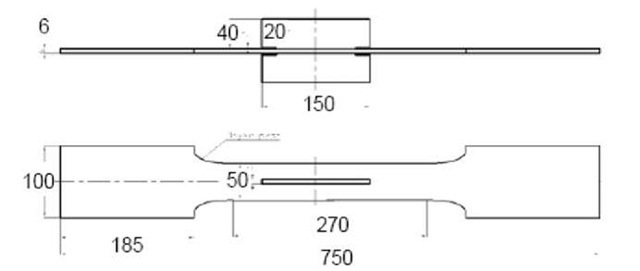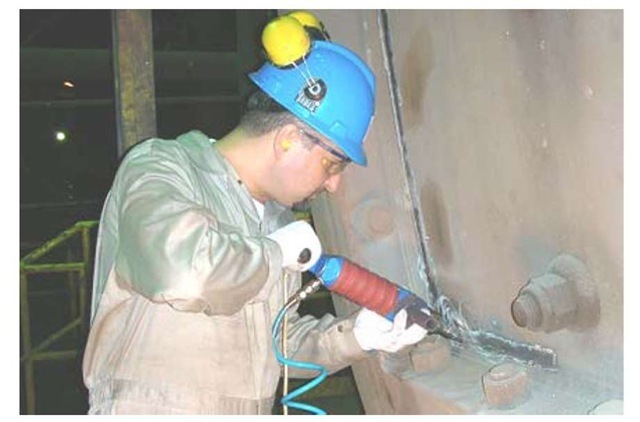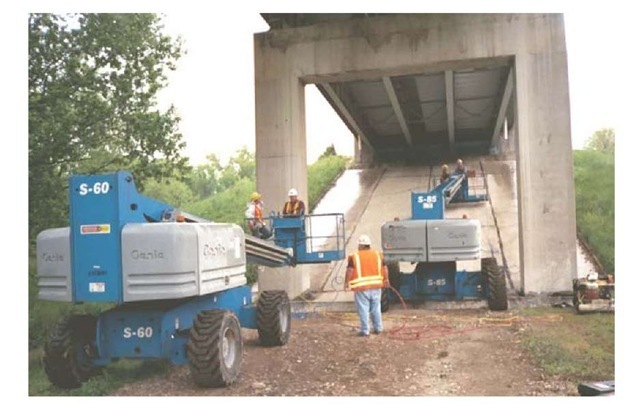Ultrasonic Peening of HSS Welded Elements
700 MPa yield strength steel
Four series of large-scale welded samples were subjected to fatigue testing to evaluate the effectiveness of UIT/UP application for fatigue life improvement of welded elements made from 350 MPa and 700 MPa yield strength steels [13]. The fatigue specimens were designed as 80 mm wide by 8 mm thick steel plates with longitudinal non-load carrying fillet welded attachments, as shown in Figure 11.
Figure 11. Welded specimen for fatigue testing of 350 and 700 MPa yield strength steel welded elements.
All testing has been conducted under constant amplitude axial tension in servo-hydraulic fatigue testing machines. The applied stress ratio has been R=0.1, with test frequencies varying from 2 to 6 Hz depending on load levels. Failure is defined to have taken place upon complete separation of the specimen. The results of fatigue testing are presented in Figure 12.
Figure 12. Fatigue test results for 350 and 700 MPa yield strength steel welded specimens [13]: 1- in as-welded condition, 350 MPa and 700 MPa yield strength steels, 2 – after UIT, 350 MPa yield strength steel, 3- after UIT/UP, 700 MPa yield strength steel, 4- FAT 112 design curve
As can be seen from Figure 12, the UIT/UP provided significant increase in fatigue performance of considered welded element for 700 MPa yield strength steel. The increase in limit stress range at 2 millions cycles of loading was 81% for welded samples treated by UIT/UP in comparison with as-welded condition, while TIG-dressing provided a 36% increase in limit stress range of welded element (see Table 2).
Table 2. Increase in limit stress range of welded element AT 2 MILLIONS CYCLES OF LOADING [13]
|
S-N curve |
Slope |
FAT value |
Improvement at |
|
|
m |
[MPa] |
FAT value [%] |
|
As-welded S355 and S700 |
-3 (fixed) |
71.3 |
- |
|
UIT/UP S700 |
-5 (fixed) |
129.4 |
81 |
|
Robotized TIG-dressing S700 |
-3 (fixed) |
97.0 |
36.0 |
960 MPa yield strength steel
Four series of large-scale welded samples were subjected also to fatigue testing to evaluate the effectiveness of UIT/UP application for fatigue life improvement of welded elements made from 960 MPa yield strength steel [14]. The fatigue specimens were designed as 50 mm wide by 6 mm thick steel plates with longitudinal non-load carrying fillet welded attachments, as shown in Figure 13.
Figure 13. Specimen geometry for fatigue testing of 960 MPa yield strength steel welded elements
The testing has been conducted under constant amplitude using R= -1. All of the as-welded specimens failed at the weld toe at the end of the longitudinal stiffeners. For the improved by UIT/UP welds, tested using constant amplitude loading, a variety of other failure modes were observed. The results of fatigue testing are presented in Figure 14.
As can be seen from Figure 14, the UIT/UP treatment with an instrument based on piezoelectric transducer provided the highest increase in fatigue performance of considered welded element for 960 MPa yield strength steel in comparison with the efficiency of application of magnetostrictive transducer and LTT electrodes.
Figure 14. Fatigue test results for 960 MPa yield strength steel welded specimens [14]: 1- in as-welded condition, 2 and 3 – after UIT/UP based on using magnetostrictive and piezoelectric transducers respectively,4- after application of LTT electrodes
Industrial Applications of UP
As was demonstrated, the UP could be effectively applied for fatigue life improvement during manufacturing, rehabilitation and repair of welded elements and structures. The UP technology and equipment were successfully applied in different industrial projects for rehabilitation and weld repair of parts and welded elements. The areas/industries where the UP was applied successfully include: Railway and Highway Bridges, Construction Equipment, Shipbuilding, Mining, Automotive and Aerospace.
An example of application of UP for repair and rehabilitation of welded elements subjected to fatigue loading in mining industry is shown in Figure 15. Around 300 meters of welds, critical from fatigue point of view, were UP treated to provide improved fatigue performance of large grinding mills.
Figure 15. Application of UP for rehabilitation of welded elements of a large grinding mill
Based on the fatigue data and the solution described in [10], the UP was also applied during the rehabilitation of welded elements of a highway bridge over the Ohio River in the USA.
The bridge was constructed about 30 years ago. The welded details of the bridge did not have macroscopic fatigue cracks. The motivation for application of the UP for fatigue life improvement of this bridge was the fatigue cracking in welded elements and failure of one of the spans of another bridge of approximately the same age and design. The stages of preparation for UP treatment of the bridge and the process of UP treatment of one of the welded vertical stiffeners are shown in Figures 16 and 17. More than two thousand and five hundred welded details of the bridge structure that were considered to be fatigue critical were UP treated.
Figure 16. Ultrasonic Peening of a welded bridge: preparation for UP treatment (two UP systems/lifts)
Figure 17. Ultrasonic Peening of a welded bridge: UP of the end of one of welded vertical stiffeners
Conclusions
1. Ultrasonic Impact Treatment (UIT/UP) is a relative new and promising technique for fatigue life improvement of welded elements and structures in materials of different strength including HSS with the yield strength of 700-1000 MPa. The results of fatigue testing show a strong tendency of increasing of fatigue strength of welded elements after application of UP with the increase in mechanical properties of the material used. It allows using to a greater degree the advantages of the HSS in welded elements, subjected to fatigue loading.
2. The fatigue testing of welded specimens also showed that the UP is the most efficient improvement treatment as compared with traditional techniques such as grinding, TIG-dressing, heat treatment, hammer peening, shot peening or application of LTT electrodes.
3. The developed computerized complex for UP was successfully used in different applications for increasing of the fatigue life of welded elements, elimination of distortions caused by welding and other technological processes, relieving of residual stress, increasing of the hardness of material surfaces and surface nanocrystallization. The areas/industries where the UP was applied successfully include: Railway and Highway Bridges, Mining, Construction Equipment, Shipbuilding, Automotive and Aerospace.

![Fatigue test results for 350 and 700 MPa yield strength steel welded specimens [13]: 1- in as-welded condition, 350 MPa and 700 MPa yield strength steels, 2 - after UIT, 350 MPa yield strength steel, 3- after UIT/UP, 700 MPa yield strength steel, 4- FAT 112 design curve Fatigue test results for 350 and 700 MPa yield strength steel welded specimens [13]: 1- in as-welded condition, 350 MPa and 700 MPa yield strength steels, 2 - after UIT, 350 MPa yield strength steel, 3- after UIT/UP, 700 MPa yield strength steel, 4- FAT 112 design curve](http://what-when-how.com/wp-content/uploads/2011/07/tmpA132_thumb2_thumb.jpg)

![Fatigue test results for 960 MPa yield strength steel welded specimens [14]: 1- in as-welded condition, 2 and 3 - after UIT/UP based on using magnetostrictive and piezoelectric transducers respectively,4- after application of LTT electrodes Fatigue test results for 960 MPa yield strength steel welded specimens [14]: 1- in as-welded condition, 2 and 3 - after UIT/UP based on using magnetostrictive and piezoelectric transducers respectively,4- after application of LTT electrodes](http://what-when-how.com/wp-content/uploads/2011/07/tmpA134_thumb2_thumb.jpg)



